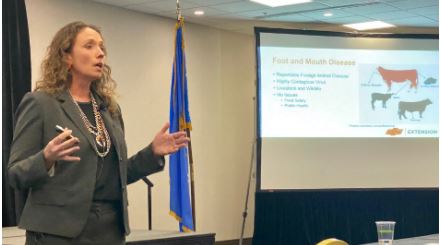
Biosecurity measures are critical in safeguarding livestock health and productivity by minimizing the risk of infectious diseases. Wildlife can serve as reservoirs for infectious agents that present threats to livestock health, leading to illness, economic losses, and potentially public health concerns. Implementing effective biosecurity strategies is essential to mitigate the transmission of diseases from wildlife to livestock.
Wildlife populations can harbor a variety of pathogens, including bacteria, viruses, and parasites. These infectious agents are capable of infecting domestic animals. For instance, wildlife, such as feral hogs, may carry bacteria such as Leptospira, which can cause leptospirosis in cattle, leading to reproductive issues and reduced production. Skunks and other species are well known for carrying rabies. Recently, migratory waterfowl have been identified as a potential source of avian influenza viruses in non-avian species.
In the 2022 Oklahoma State University Cow-Calf Biosecurity Survey, funded by the USDA National Animal Preparedness and Response Program, 50% of producers indicated that wild deer, elk, or antelope were found on their cattle operations. Most producers are likely able to identify multiple forms of wildlife on their operations, and depending on the species, appropriately managed species can be useful in improving environmental balance on the farm or ranch. However, it is important to understand if a disease risk is present.
When considering which practices to implement, disease risk assessments in coordination with a veterinarian should take place, and recognition of the need for biodiversity on the operation must be considered. Basic biosecurity measures can assist producers in limiting disease risks including those posed by wildlife interactions.
Operations should select a biosecurity manager. This individual is responsible for developing a biosecurity plan in cooperation with the operation’s veterinarian. This plan should be written and reevaluated at least on an annual basis. Training of the operational team should occur and, the biosecurity manager should stay in tune with any changes involving new disease identification and outbreaks.
Monitoring animal health of both domestic and wildlife species is a critical biosecurity practice. Livestock should be monitored on a daily basis and any signs of illness documented. Developing a herd health plan advised by a veterinarian, including vaccination and treatment protocols, is essential. Any abnormal or unusual signs of illness or death, including those seen in wildlife, should be reported to the operation veterinarian and animal health officials.
Managing wildlife populations at appropriate levels can promote both good biosecurity and environmental health as long as disease risk is considered. Consulting with local, state, and federal wildlife entities, such as US Fish & Wildlife, USDA APHIS Wildlife Services, and state agriculture/wildlife departments, is advised to fully understand current populations and acceptable legal measures to address wildlife.
Physical separation of livestock from wildlife that present disease risks can be challenging, but must be considered. Fences often limit direct contact of livestock with certain wildlife species. Guardian animals can also deter certain wildlife species, especially predators. Managing access to livestock feed and water resources may be necessary. Producers should be careful to not inadvertently create wildlife habitats that promote disease spread. Additionally, care should also be taken to prevent wildlife access to animal disposal locations, as scavengers have the potential to spread unwanted illness.
Protecting livestock health against wildlife-borne diseases requires an everchanging multifaceted approach that combines practical and economically feasible management strategies. By implementing operation specific biosecurity measures tailored to the risks posed by wildlife, producers can mitigate disease transmission, promote animal welfare, and create environmentally sustainable production systems.
More information about biosecurity can be found at www.bqa.org and www.securebeef.org














